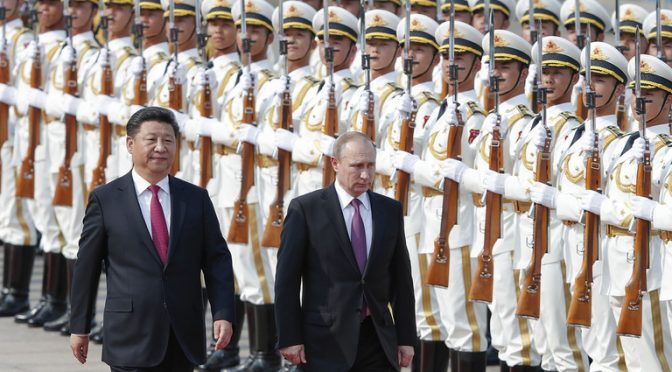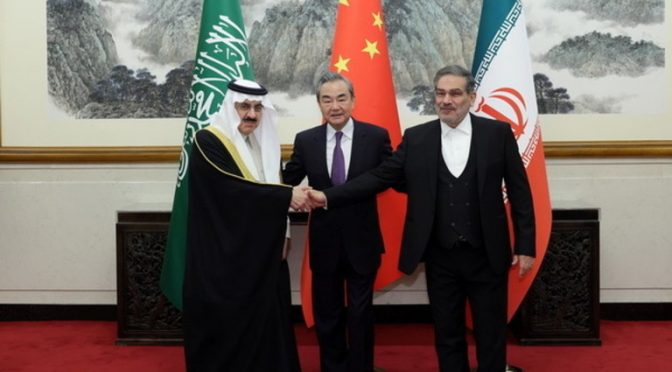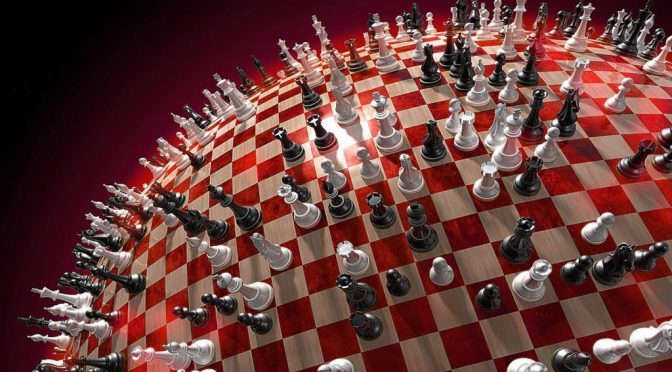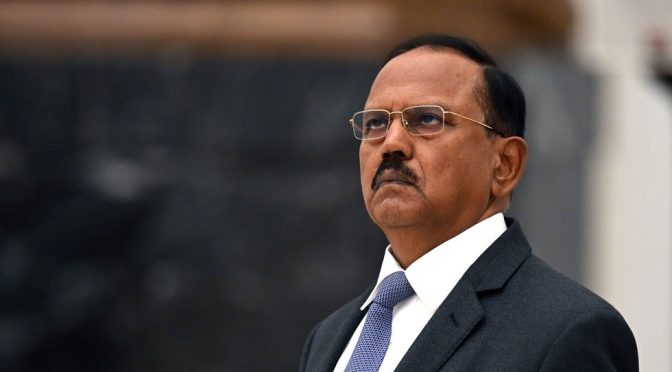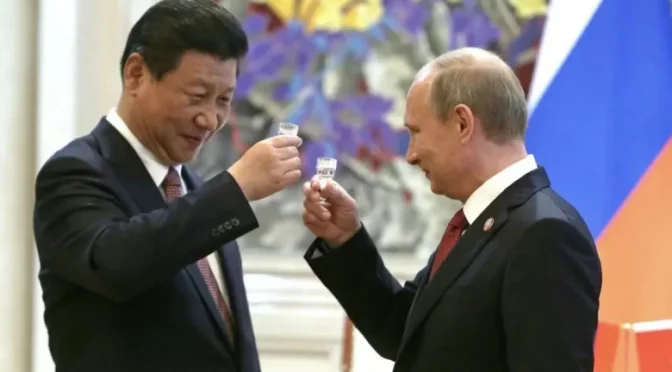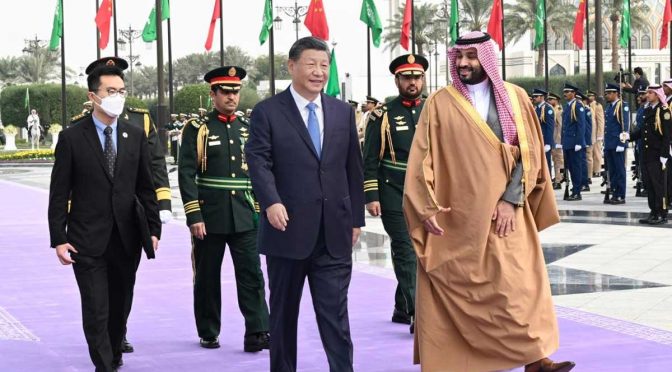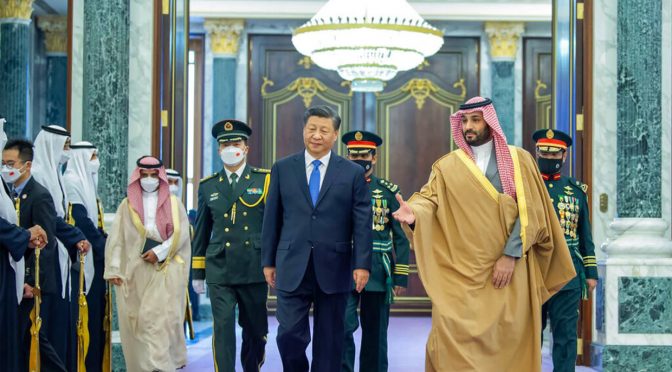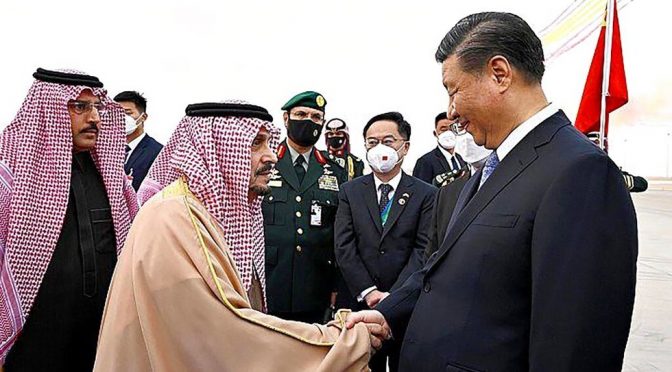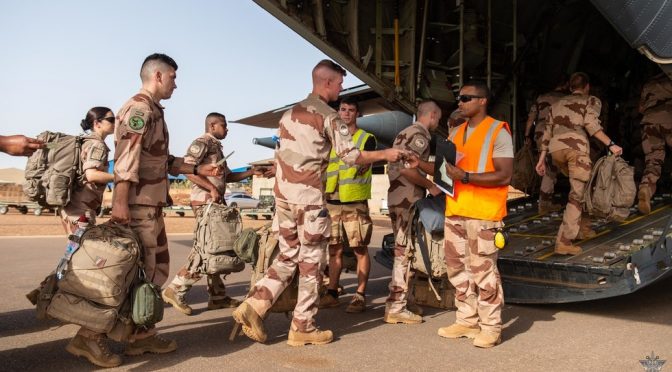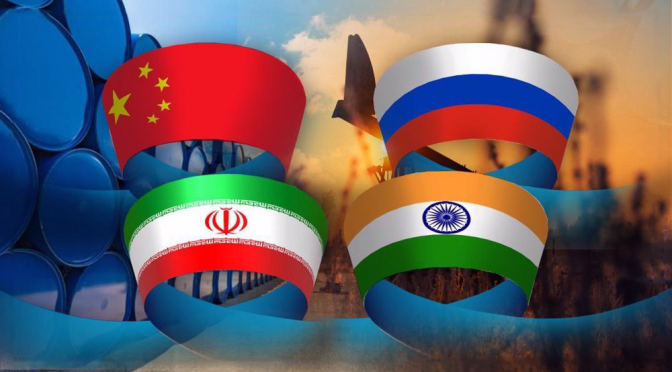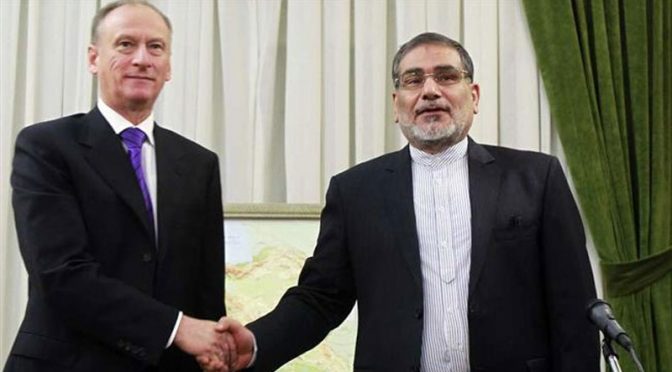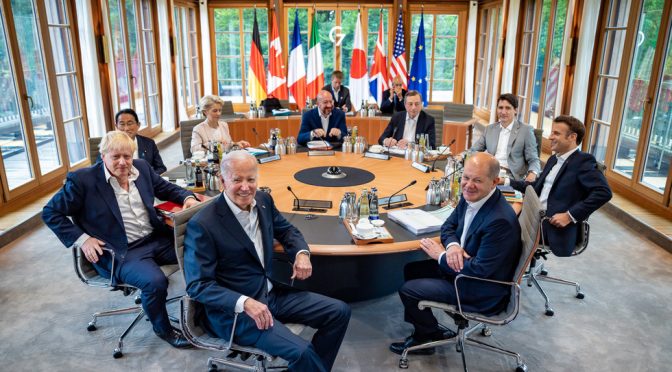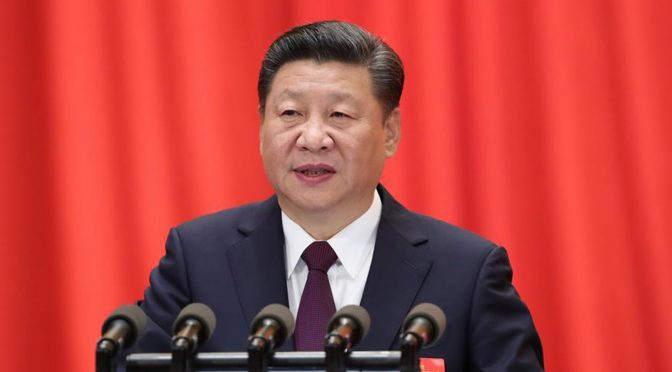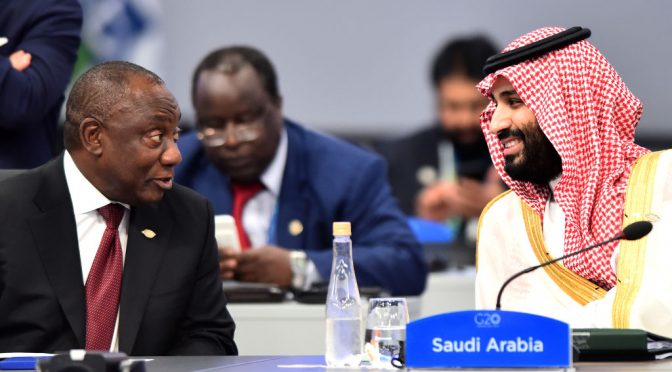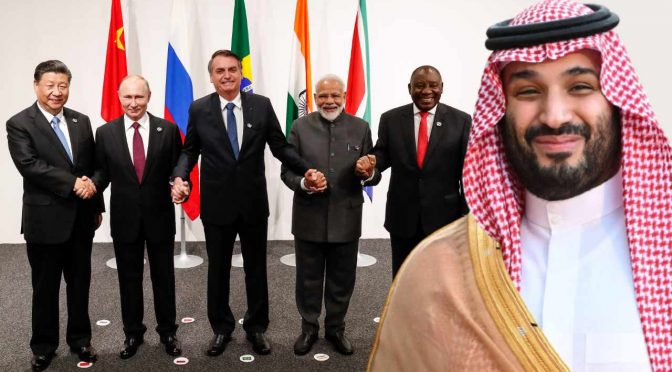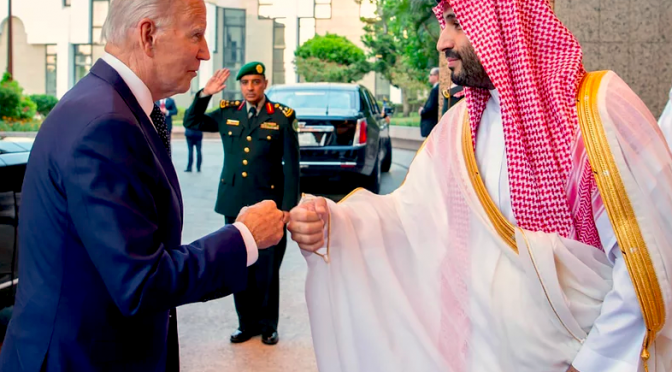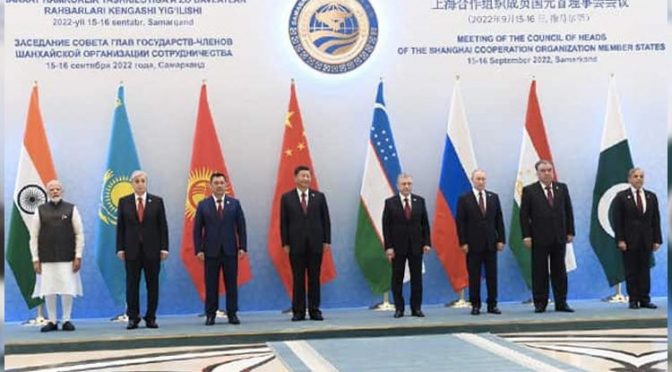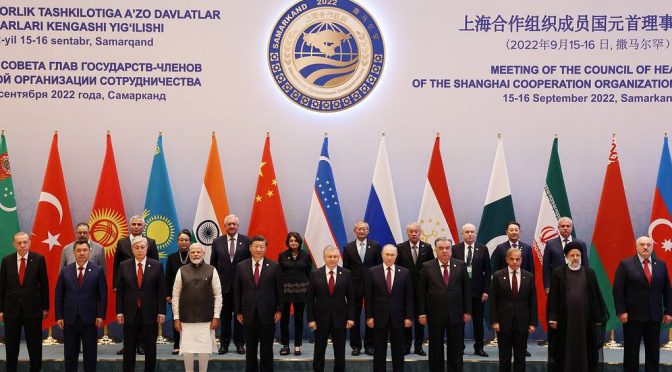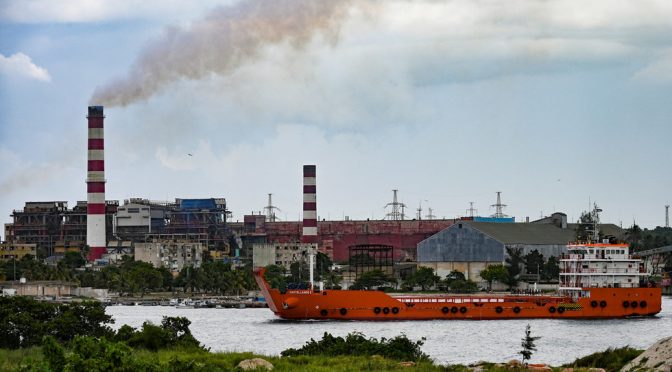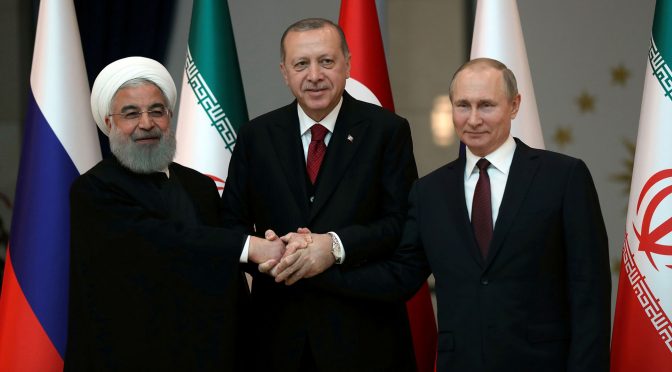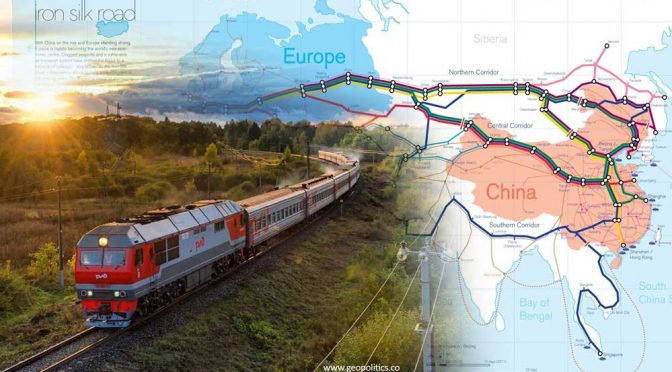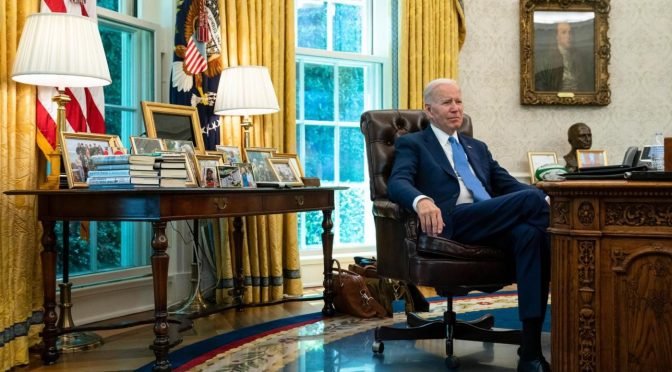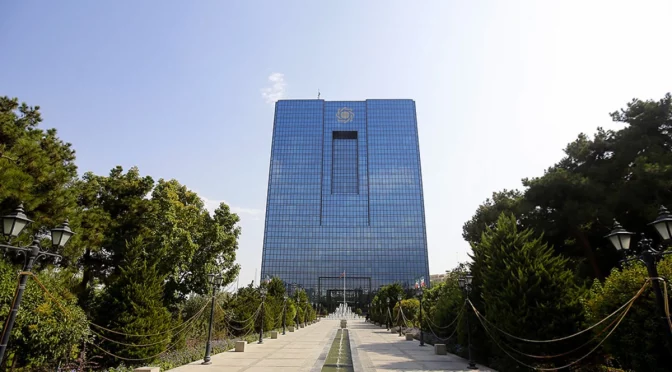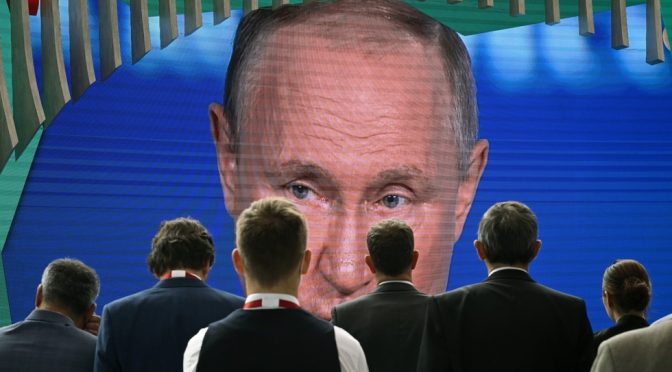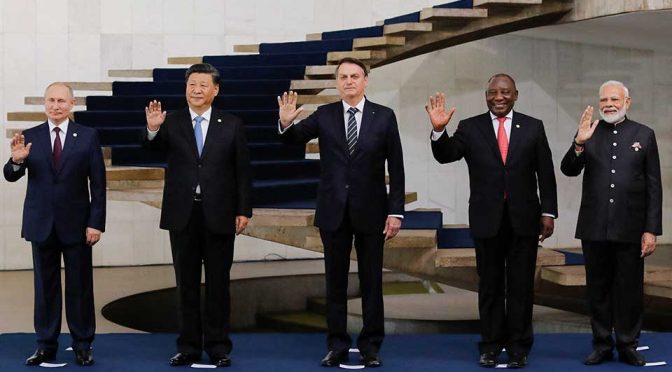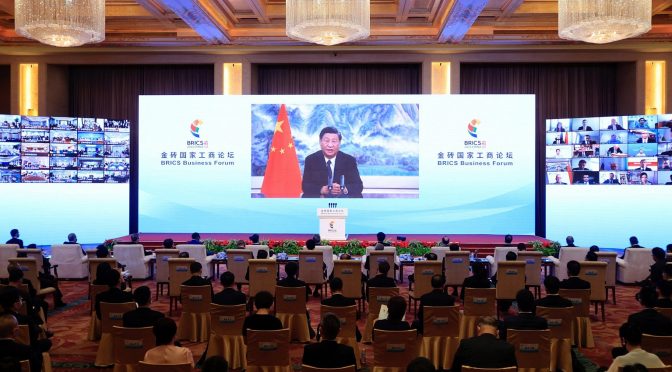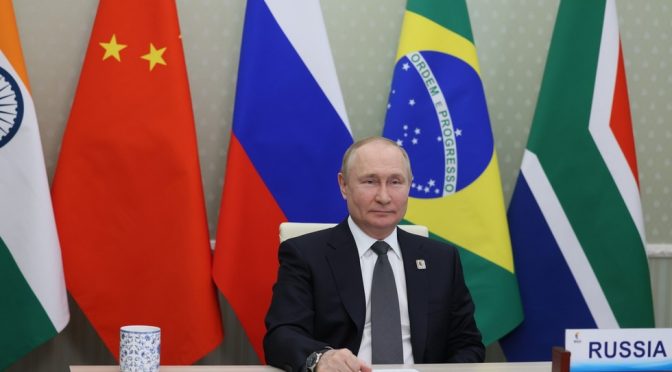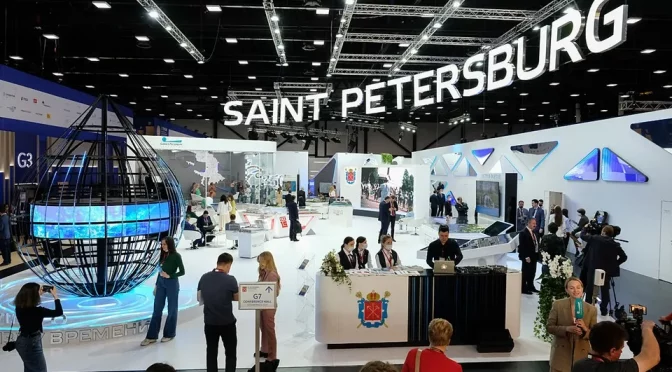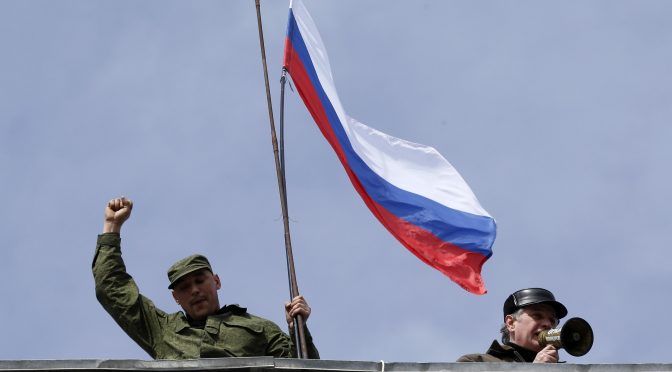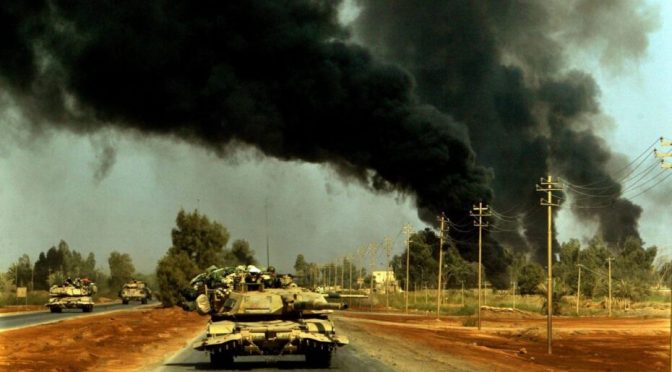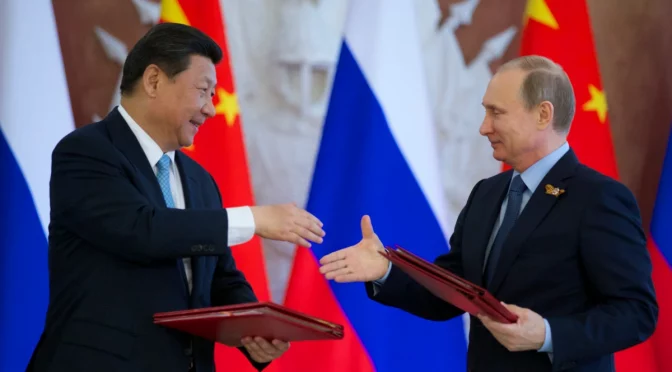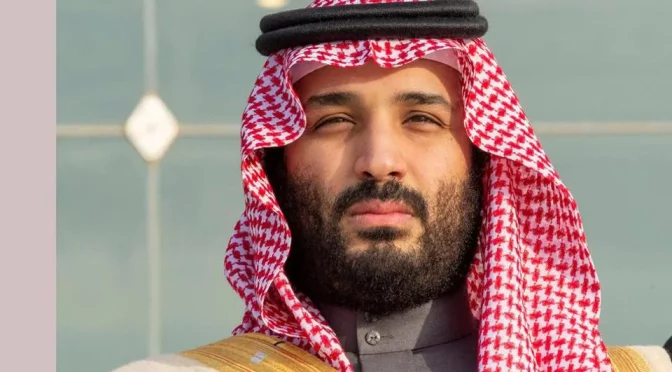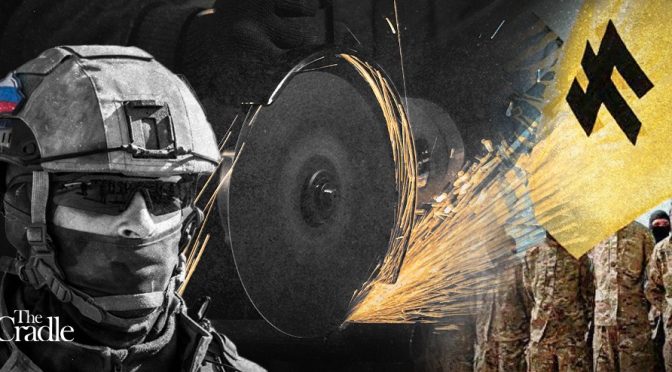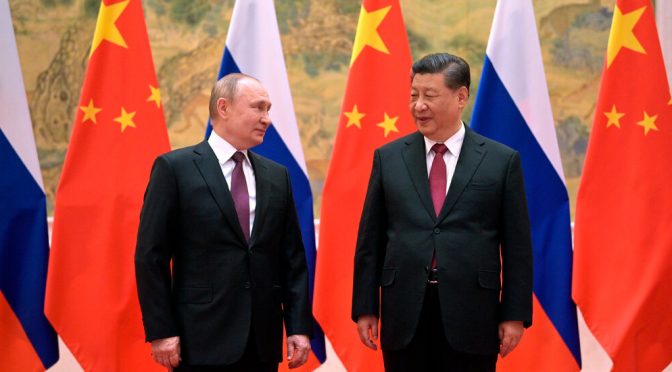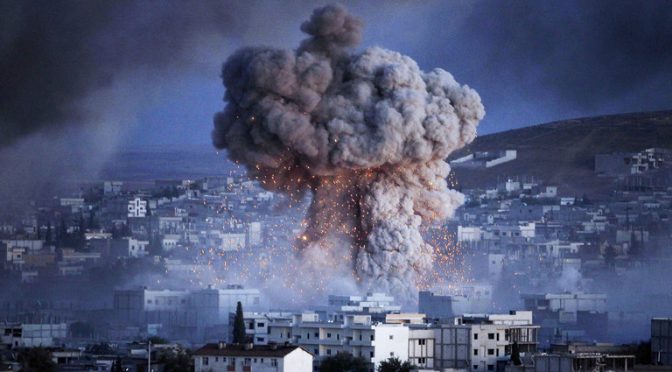So much has been said about Xi Jinping’s visit to Russia last week, that the descriptive genre has been exhausted. What is needed instead is either details on specific aspects or some sort of in-depth socio-cultural analysis.
Continue reading What You Need to Know About Russia-China Relations, But Were Afraid to AskCategory Archives: Multipolar World
Brazil and China Sign Pact to Abandon Dollar
The two BRICS nations will now reportedly trade in their own currencies.
Continue reading Brazil and China Sign Pact to Abandon DollarGlobal South Solidarity is the Key to Lifting Up Central America – Not Washington’s Monroe Doctrine
The US is angry at Latin American nations getting close to China, but the only alternative on offer is imperialist exploitation.
Continue reading Global South Solidarity is the Key to Lifting Up Central America – Not Washington’s Monroe DoctrineThe Middle East frees itself from the West
The reconciliation between Saudi Arabia, leader of the Sunni Muslim world, and Iran, leader of the Shiite Muslim world, finally makes possible an era of peace in the Middle East. It was made possible by Russia, ally of the two enemy brothers, and negotiated first in Iraq and Oman before being concluded by China, Iran’s millennial ally, acting impartially. This agreement closes eleven years of wars and Western influence.
Continue reading The Middle East frees itself from the WestHow the China-brokered Saudi-Iran Deal will Change the Middle East
Last week, Saudi Arabia and Iran announced a landmark deal, brokered by China in Beijing, to formally restore diplomatic relations. The agreement saw the two sectarian arch rivals in the Middle East agree to put aside their differences and to normalize ties.
It was the first ever deal of its kind overseen by China, framing itself as a peacemaker, and showing that its commitment to have good relations with every country in the region is not just based on rhetoric but actual substance. Some have described it as a sign of a “changing global order.”
To put it mildly, it is bad news for the United States and deals a massive blow to the near-unlimited geopolitical sway Washington has long held over the region via its strategic relationships with countries such as Saudi Arabia.
Additionally, it effectively ruins a US led campaign to pressurize and isolate Iran and hinders American efforts to shape regional politics in Israel’s favor via the Abraham Accords. It is no surprise that the Western media is calling the Chinese-brokered deal a “challenge” to the international order, but what order is that? The ability of the US to dominate the Middle East? Perhaps brokering peace is a good thing.
US foreign policy in the Middle East
Since the decline of European colonial empires, the United States has been the sole military hegemon in the Middle East, using a network of partnerships from Israel to the Gulf States to sustain domination over the region and allowing the US to exploit its energy resources. In order to maintain this position, the US has long needed adversaries in order to perpetuate an ongoing security dilemma and force reliance on it as a security guarantor, which is also beneficial to the US military industrial complex. These policies have accumulated decades worth of wars, insurgencies and attempts at regime change.
Detractors to the US agenda have included revolutionary Arabist regimes, such as Saddam Hussein’s Iraq and Bashar Assad’s Syria, terrorist groups such as Al-Qaeda and ISIS, and of course the post-1979 Islamic Republic of Iran. It was after the US gave up on its botched attempt to topple Assad that policymakers in the Trump administration decided to focus on Tehran, tearing up US participation in the Joint Comprehensive Plan of Action (JCPOA) and imposing a crippling sanctions regime. In retaliation, Iran has waged a series of proxy conflicts against US partners in the region, most notably assisting the Houthis in Yemen against the Saudi-backed government, which has overseen the carpet-bombing of occupied regions.
China’s policy in the Middle East
Unlike the United States, China’s policy in the Middle East is non-interventionist, and assumes a neutral posture in regional conflicts, taking a position of respect for national sovereignty. However, this does not mean Beijing has no interests in the region. As it grows and develops domestically, its need for secure access to energy resources has increased, leading it on a diplomatic push to build good relations with every country in the region, and this has only accelerated as the US has pushed to isolate China from the West. Despite the intra-regional power struggle, in the past two years, Beijing announced strategic partnerships with both Iran and the Gulf States.
Multipolarity
Because China did not have the same military footprint or stakes in the Middle East as the US, many analysts were dismissive of Beijing’s ability to seriously act as a diplomatic mediator in the region. They believed that its attempts to build good ties with everyone were spread too thin. However, the Saudi-Iran deal shows this assumption was wrong. But how did it happen?
First, it should be noted that the Gulf States are not “value” allies to the US in the way European countries are, and not “morally obligated” to follow the American cause. Rather, they are self-interested monarchies with very different ideological and value systems (strict Wahhabi Islam) and have seen the US as a “patron” in guaranteeing their economic and security interests (oil for weapons). This is not a “marriage”, just business.
It should be understood that the world has changed in ways which now lead these states to perceive that unparalleled US dominance, which is its unequivocal foreign policy goal, is no longer in their best interests. They have found a new, bigger partner in Beijing who not only can buy more of their oil, but also doesn’t have a foreign policy doctrine premised on evangelizing its ideology or creating war throughout the region. As such, when the US delivered an ultimatum to the United Arab Emirates that they will block the export of F-35s if they don’t drop Huawei from their 5G networks, Abu Dhabi told Washington where to go.
While this shift was already underway by 2022, events last year exacerbated it further as the Gulf States suddenly found the US demanding that they take sides in a war – in Ukraine – which did not concern them, and worse still, demanding that they compromise their own economic interests to suit its sanctions agenda.
The US fell out with OPEC, and Saudi Arabia publicly rebuffed its demands to increase oil production. Meanwhile, the events of that year also emboldened Iran, who was not being swayed by US pressure, while the return of Benjamin Netanyahu to power in Israel exacerbated Arab-Israeli tensions, damaging the US backed Abraham Accords, and hindering Saudi Arabia’s willingness to normalize with Israel.
These events have ultimately created the political space for a diplomatic reconciliation between Saudi Arabia and Iran, backed by China. It’s a massive blow to American interests as it is the first major Middle East deal brokered without Washington’s influence, and subsequently dilutes its policy of creating a perpetual war machine in order to legitimize its footprint in the region and its clout over Arab States.
It also shows that the US campaign to try and isolate and crush Iran has failed, and that the United States no longer holds the power it once did to isolate countries. If the US is wise, it should use this development to rethink its approach to the Middle East, but if other policies are anything to go by, the Washington circle is likely to continue to think every problem is a nail, and more hammers are needed.
In a Multipolar World, the Idea of a New World Order Dies
When former US President George W. Bush and his neocon regime launched their anti-terrorism campaign after the September 11th attacks, he declared that “Every nation, in every region, now has a decision to make. Either you are with us, or you are with the terrorists.”
Continue reading In a Multipolar World, the Idea of a New World Order DiesWho is India’s National Security Advisor and Why did Putin Decide to Meet Him One on One?
The Russian president has held a surprise meeting with AK Doval, PM Modi’s most trusted foreign and domestic aide.
Continue reading Who is India’s National Security Advisor and Why did Putin Decide to Meet Him One on One?The Stage is Set for A Full Blown Hybrid World War III
The strategists of Russia and China are now working full time on how to return all strands of Hybrid War against the Hegemon.
Continue reading The Stage is Set for A Full Blown Hybrid World War IIIRussia’s Sergey Glazyev Introduces the New Global Financial System
The world’s new monetary system, underpinned by a digital currency, will be backed by a basket of new foreign currencies and natural resources. And it will liberate the Global South from both western debt and IMF-induced austerity.
Continue reading Russia’s Sergey Glazyev Introduces the New Global Financial SystemThe World Teetering on the New Polycentric Geopolitics
The world is yet to see how dangerous the decade before us will be, what the new global geopolitical architecture will look like and who is to build it.
Continue reading The World Teetering on the New Polycentric GeopoliticsCan You Smell What the Year of the Rabbit is Cooking?
The New Silk Roads, or BRI, as well as the integration efforts of BRICS+, the SCO and the EAEU will be on the forefront of Chinese policy.
Continue reading Can You Smell What the Year of the Rabbit is Cooking?Why BRI is Back With A Bang in 2023
As Beijing’s Belt and Road Initiative enters its 10th year, a strong Sino-Russian geostrategic partnership has revitalized the BRI across the Global South.
Continue reading Why BRI is Back With A Bang in 2023Xi of Arabia and the Petroyuan Drive
Xi Jinping has made an offer difficult for the Arabian Peninsula to ignore: China will be guaranteed buyers of your oil and gas, but we will pay in yuan.
Continue reading Xi of Arabia and the Petroyuan DriveChina’s Win-Win Arrangement with Saudi Arabia
Beijing manages to maintain strategic partnerships with other countries despite their ongoing sectarian disputes.
Continue reading China’s Win-Win Arrangement with Saudi ArabiaWhat the Historic China-Arab Summits Mean for the Middle East
Xi Jinping’s visit to Saudi Arabia signals a desire by Arab nations to hedge their bets with stronger partnerships beyond the US.
Continue reading What the Historic China-Arab Summits Mean for the Middle EastMali Kicks Out France in Favor of Russia
The global geopolitical shift continues with the Republic of Mali kicking out blackmailer France and its NGOs, in favor of Russian economic and security cooperation.
Continue reading Mali Kicks Out France in Favor of RussiaRussia, India, China, Iran: the Quad that really matters
Southeast Asia is right at the center of international relations for a whole week viz a viz three consecutive summits: Association of South East Asian Nations (ASEAN) summit in Phnom Penh, the Group of Twenty (G20) summit in Bali, and the Asia-Pacific Economic Cooperation (APEC) summit in Bangkok.
Continue reading Russia, India, China, Iran: the Quad that really mattersRewiring Eurasia
The meeting this week between two Eurasian security bosses is a further step toward dusting away the west’s oversized Asian footprint.
Continue reading Rewiring EurasiaDoes the West Think We’re Fools?
President of the Socialist Party of Zambia, Fred M’membe, and the convener of the Socialist Movement of Ghana, Kyeretwie Opoku, slammed the West’s arrogant attitude towards African countries.
Continue reading Does the West Think We’re Fools?Birth of NWO Where West Will Have to Live Within Its Means
It’s time for the Global Majority to take their rightful place at the top table.
Continue reading Birth of NWO Where West Will Have to Live Within Its Means‘Peaceful modernization’: China’s offering to the Global South
Xi Jinping just offered the Global South a stark alternative to decades of western diktats, war, and economic duress. ‘Peaceful modernization’ will establish sovereignty, economy, and independence for the world’s struggling states.
Continue reading ‘Peaceful modernization’: China’s offering to the Global SouthSaudi Arabia Looks To Join BRICS Next Year
Saudi Arabia expressed interest in being part of the BRICS economic bloc as it pivots away from Washington. Conversations with the alternative counter-western alliance representative, South African President Cyril Ramaphosa, started the ball rolling.
Continue reading Saudi Arabia Looks To Join BRICS Next YearSaudi Arabia Joining the BRICS Shows the World is Moving On from Western Dominance
Two decades on from its emergence as a marketing ploy, the concept has enjoyed an unlikely upturn.
Continue reading Saudi Arabia Joining the BRICS Shows the World is Moving On from Western DominanceOPEC’s Body Blow to Biden
The OPEC+ decision could change the security picture in West Asia more than anything since the 1979 Iranian Revolution.
Continue reading OPEC’s Body Blow to BidenPutin Wants A Grand Bargain with the West for A Multipolar Global Order
The Russian president would like to negotiate a new place for his country in the world order, an Ankara official claims.
Continue reading Putin Wants A Grand Bargain with the West for A Multipolar Global Order‘Samarkand Spirit’ to Be Driven by ‘Responsible Powers’ Russia and China
Amidst serious tremors in the world of geopolitics, it is so fitting that this year’s Shanghai Cooperation Organization (SCO) heads of state summit should have taken place in Samarkand – the ultimate Silk Road crossroads for 2,500 years.
Continue reading ‘Samarkand Spirit’ to Be Driven by ‘Responsible Powers’ Russia and ChinaSCO Expansion to Give Region Greater Security, Stability
Member-countries welcomed the signing of memorandums of understanding with the League of Arab States, UNESCO, the Economic and Social Commission for Asia and the Pacific.
Continue reading SCO Expansion to Give Region Greater Security, StabilityAsia’s Future Takes Shape in Vladivostok, the Russian Pacific
Sixty-eight countries gathered on Russia’s far eastern coast to listen to Moscow’s economic and political vision for the Asia-Pacific
Continue reading Asia’s Future Takes Shape in Vladivostok, the Russian PacificEurasian Union Eyes Creating Industrial Park in Cuba
The proposed deal envisions lending a plot of land on the island to the EEU bloc for 50 years. The Eurasian project is in deep contrast over any American Manifest Destiny project, which is designed to exploit and control the natural and human resources of the targeted region. – CG
Continue reading Eurasian Union Eyes Creating Industrial Park in CubaPutin’s Syrian Peace Plan with Erdogan
Russian President Vladmir Putin and Turkish President Recep Erdogan held a four-hour meeting on August 5 in Sochi which may change the course of the Middle East, and end the US occupation of Syria.
Continue reading Putin’s Syrian Peace Plan with ErdoganMultipolar “Iran-Russia-Turkey Troika” Overshadows “Unipolar Joe Biden” in West Asia
The presidents of Russia, Iran, and Turkey convened to discuss critical issues pertaining to West Asia, with the illegal US occupation of Syria a key talking point.
Continue reading Multipolar “Iran-Russia-Turkey Troika” Overshadows “Unipolar Joe Biden” in West AsiaIn Eurasia, the War of Economic Corridors is in Full Swing
Mega Eurasian organizations and their respective projects are now converging at record speed, with one global pole way ahead of the other.
The War of Economic Corridors is now proceeding full speed ahead, with the game-changing first cargo flow of goods from Russia to India via the International North South Transportation Corridor (INSTC) already in effect.
Very few, both in the east and west, are aware of how this actually has long been in the making: the Russia-Iran-India agreement for implementing a shorter and cheaper Eurasian trade route via the Caspian Sea (compared to the Suez Canal), was first signed in 2000, in the pre-9/11 era.
The INSTC in full operational mode signals a powerful hallmark of Eurasian integration – alongside the Belt and Road Initiative (BRI), the Shanghai Cooperation Organization (SCO), the Eurasian Economic Union (EAEU), and last but not least, what I described as “Pipelineistan” two decades ago.
Caspian is key
Let’s have a first look on how these vectors are interacting.
The genesis of the current acceleration lies in Russian President Vladimir Putin’s recent visit to Ashgabat, Turkmenistan’s capital, for the 6th Caspian Summit. This event not only brought the evolving Russia-Iran strategic partnership to a deeper level, but crucially, all five Caspian Sea littoral states agreed that no NATO warships or bases will be allowed on site.
That essentially configures the Caspian as a virtual Russian lake, and in a minor sense, Iranian – without compromising the interests of the three “stans,” Azerbaijan, Kazakhstan and Turkmenistan. For all practical purposes, Moscow has tightened its grip on Central Asia a notch.
As the Caspian Sea is connected to the Black Sea by canals off the Volga built by the former USSR, Moscow can always count on a reserve navy of small vessels – invariably equipped with powerful missiles – that may be transferred to the Black Sea in no time if necessary.
Stronger trade and financial links with Iran now proceed in tandem with binding the three “stans” to the Russian matrix. Gas-rich republic Turkmenistan for its part has been historically idiosyncratic – apart from committing most of its exports to China.
Under an arguably more pragmatic young new leader, President Serdar Berdimuhamedow, Ashgabat may eventually opt to become a member of the SCO and/or the EAEU.
Caspian littoral state Azerbaijan on the other hand presents a complex case: an oil and gas producer eyed by the European Union (EU) to become an alternative energy supplier to Russia – although this is not happening anytime soon.
The West Asia connection
Iran’s foreign policy under President Ebrahim Raisi is clearly on a Eurasian and Global South trajectory. Tehran will be formally incorporated into the SCO as a full member in the upcoming summit in Samarkand in September, while its formal application to join the BRICS has been filed.
Purnima Anand, head of the BRICS International Forum, has stated that Turkey, Saudi Arabia and Egypt are also very much keen on joining BRICS. Should that happen, by 2024 we could be on our way to a powerful West Asia, North Africa hub firmly installed inside one of the key institutions of the multipolar world.
As Putin heads to Tehran next week for trilateral Russia, Iran, Turkey talks, ostensibly about Syria, Turkish President Recep Tayyip Erdogan is bound to bring up the subject of BRICS.
Tehran is operating on two parallel vectors. In the event the Joint Comprehensive Plan of Action (JCPOA) is revived – a quite dim possibility as it stands, considering the latest shenanigans in Vienna and Doha – that would represent a tactical victory. Yet moving towards Eurasia is on a whole new strategic level.
In the INSTC framework, Iran will make maximum good use of the geostrategically crucial port of Bandar Abbas – straddling the Persian Gulf and the Gulf of Oman, at the crossroads of Asia, Africa and the Indian subcontinent.
Yet as much as it may be portrayed as a major diplomatic victory, it’s clear that Tehran will not be able to make full use of BRICS membership if western – especially US – sanctions are not totally lifted.
Pipelines and the “stans”
A compelling argument can be made that Russia and China might eventually fill the western technology void in the Iranian development process. But there’s a lot more that platforms such as the INSTC, the EAEU and even BRICS can accomplish.
Across “Pipelineistan,” the War of Economic Corridors gets even more complex. Western propaganda simply cannot admit that Azerbaijan, Algeria, Libya, Russia’s allies at OPEC, and even Kazakhstan are not exactly keen on increasing their oil production to help Europe.
Kazakhstan is a tricky case: it is the largest oil producer in Central Asia and set to be a major natural gas supplier, right after Russia and Turkmenistan. More than 250 oil and gas fields are operated in Kazakhstan by 104 companies, including western energy giants such as Chevron, Total, ExxonMobil and Royal Dutch Shell.
While exports of oil, natural gas and petroleum products comprise 57 percent of Kazakhstan’s exports, natural gas is responsible for 85 percent of Turkmenistan’s budget (with 80 percent of exports committed to China). Interestingly, Galkynysh is the second largest gas field on the planet.
Compared to the other “stans,” Azerbaijan is a relatively minor producer (despite oil accounting for 86 percent of its total exports) and basically a transit nation. Baku’s super-wealth aspirations center on the Southern Gas Corridor, which includes no less than three pipelines: Baku-Tblisi-Erzurum (BTE); the Turkish-driven Trans-Anatolian Natural Gas Pipeline (TANAP); and the Trans-Adriatic (TAP).
The problem with this acronym festival – BTE, TANAP, TAP – is that they all need massive foreign investment to increase capacity, which the EU sorely lacks because every single euro is committed by unelected Brussels Eurocrats to “support” the black hole that is Ukraine. The same financial woes apply to a possible Trans-Caspian Pipeline which would further link to both TANAP and TAP.
In the War of Economic Corridors – the “Pipelineistan” chapter – a crucial aspect is that most Kazakh oil exports to the EU go through Russia, via the Caspian Pipeline Consortium (CPC). As an alternative, the Europeans are mulling on a still fuzzy Trans-Caspian International Transport Route, also known as the Middle Corridor (Kazakhstan-Turkmenistan-Azerbaijan-Georgia-Turkey). They actively discussed it in Brussels last month.
The bottom line is that Russia remains in full control of the Eurasia pipeline chessboard (and we’re not even talking about the Gazprom-operated pipelines Power of Siberia 1 and 2 leading to China).
Gazprom executives know all too well that a fast increase of energy exports to the EU is out of the question. They also factor the Tehran Convention – that helps prevent and control pollution and maintain the environmental integrity of the Caspian Sea, signed by all five littoral members.
Breaking BRI in Russia
China, for its part, is confident that one of its prime strategic nightmares may eventually disappear. The notorious “escape from Malacca” is bound to materialize, in cooperation with Russia, via the Northern Sea Route, which will shorten the trade and connectivity corridor from East Asia to Northern Europe from 11,200 nautical miles to only 6,500 nautical miles. Call it the polar twin of the INSTC.
This also explains why Russia has been busy building a vast array of state-of-the-art icebreakers.
So here we have an interconnection of New Silk Roads (the INSTC proceeds in parallel with BRI and the EAEU), Pipelineistan, and the Northern Sea Route on the way to turn western trade domination completely upside down.
Of course, the Chinese have had it planned for quite a while. The first White Paper on China’s Arctic policy, in January 2018, already showed how Beijing is aiming, “jointly with other states” (that means Russia), to implement sea trade routes in the Arctic within the framework of the Polar Silk Road.
And like clockwork, Putin subsequently confirmed that the Northern Sea Route should interact and complement the Chinese Maritime Silk Road.
Russia-China Economic cooperation is evolving on so many complex, convergent levels that just to keep track of it all is a dizzying experience.
A more detailed analysis will reveal some of the finer points, for instance how BRI and SCO interact, and how BRI projects will have to adapt to the heady consequences of Moscow’s Operation Z in Ukraine, with more emphasis being placed on developing Central and West Asian corridors.
It’s always crucial to consider that one of Washington’s key strategic objectives in the relentless hybrid war against Russia was always to break BRI corridors that crisscross Russian territory.
As it stands, it’s important to realize that dozens of BRI projects in industry and investment and cross-border inter-regional cooperation will end up consolidating the Russian concept of the Greater Eurasia Partnership – which essentially revolves around establishing multilateral cooperation with a vast range of nations belonging to organizations such as the EAEU, the SCO, BRICS and ASEAN.
Welcome to the new Eurasian mantra: Make Economic Corridors, Not War.
Russia and China Haven’t Even Started to Ratchet Up the Pain Dial Yet
The Suicide Spectacular Summer Show, currently on screen across Europe, proceeds in full regalia, much to the astonishment of virtually the whole Global South: a trashy, woke Gotterdammerung remake, with Wagnerian grandeur replaced by twerking.
Continue reading Russia and China Haven’t Even Started to Ratchet Up the Pain Dial YetThree More Countries Set to Join BRICS
The kingdom of Saudi Arabia, along with Turkey and Egypt, may apply next year, the BRICS Forum president told Russian media.
Continue reading Three More Countries Set to Join BRICSIran-Russia Interbank Agreement Soon to Be Implemented
The pursuit of inter-banking agreements comes amid efforts by Tehran and Moscow to strengthen their economies and bypass western sanctions.
Continue reading Iran-Russia Interbank Agreement Soon to Be ImplementedRussia’s Decisive Break with the West Help Shape A Multipolar World Order
It’s perhaps hard to believe now but – only eight years ago – Russia was a full member of the former G8. Since then, there have been dramatic changes.
Continue reading Russia’s Decisive Break with the West Help Shape A Multipolar World OrderBRICS+ & Global South: Emerging Leaders of a Multipolar World?
Fast but not furious, the Global South is revving up. The key takeaway of the BRICS+ summit in Beijing, held in sharp contrast with the G7 in the Bavarian Alps, is that both West Asia’s Iran and South America’s Argentina officially applied for BRICS membership.
Continue reading BRICS+ & Global South: Emerging Leaders of a Multipolar World?The ‘Multiplier Effect’ of BRICS+
The possibilities offered by the “integration of integrations” track for BRICS+ are substantial, provided that such a platform is open, inclusive and ensures connectivity across regional integration arrangements – this will deliver the much needed “multiplier effect” in the process of economic cooperation and can set off a new process of globalization that connects regional arrangements in the developed and the developing world, writes Valdai Club Programme Director Yaroslav Lissovolik.
Continue reading The ‘Multiplier Effect’ of BRICS+Exile on Main Street: The Sound of the Unipolar World Fading Away
The future world order, already in progress, will be formed by strong sovereign states. The ship has sailed. There’s no turning back.
Continue reading Exile on Main Street: The Sound of the Unipolar World Fading AwaySt. Petersburg sets the stage for the War of Economic Corridors
In St. Petersburg, the world’s new powers gather to upend the US-concocted “rules-based order” and reconnect the globe their way.
Continue reading St. Petersburg sets the stage for the War of Economic CorridorsThe ‘New G8’ Meets China’s ‘Three Rings’
The coming of the new G8 points to the inevitable advent of BRICS +, one of the key themes to be discussed in the upcoming BRICS summit in China.
Continue reading The ‘New G8’ Meets China’s ‘Three Rings’Russia is Staging A Rebellion Against the West and its Liberal World Order
Moscow has been unwilling to accept the secondary role assigned to it by the West and now the consequences are being felt.
Continue reading Russia is Staging A Rebellion Against the West and its Liberal World OrderThe Empire Strikes Back: Imperialism’s Global War on Multipolarity
This is a series of talks where each talk is short and one can enjoy the long video in shorter pieces. An absolute must-listen is the convenor’s opening statement which explains so clearly the concept of multi-polarity or pluripolarity.
The second one by Victor Gao brings a new view to how China perceives these changes in our world.
Ben Norton from Multipolarista takes a look at the influence of socialism in the Belt and Road Initiative.
All of these are worth listening to, and it is easy as the presentations are short, and one can come back to it.
Topics include: * NATO, AUKUS and the military infrastructure of the New Cold War * The evolving China-Russia relationship and the West’s response * The Biden administration’s undermining of the One China Principle * Solomon Islands and the West’s plan for hegemony in the Pacific * NATO’s plan for Ukraine and how this impacts China * Prospects for sovereign development in the Global South
Speakers: * Victor Gao (Vice President, Center for China and Globalization) * Ben Norton (Editor, Multipolarista) * Li Jingjing (Reporter, CGTN) * Jenny Clegg (Author, ‘China’s Global Strategy: Toward a Multipolar World’) * Danny Haiphong (Author, ‘American Exceptionalism and American Innocence’) * Chris Matlhako (SACP Second Deputy General Secretary) * Mustafa Hyder Sayed (Executive Director, Pakistan-China Institute)
* Professor Ding Yifan (Senior Fellow, Taihe Institute, China) * Ju-Hyun Park (Writer and organizer, Nodutdol for Korean Community Development) * Rob Kajiwara (President, Peace For Okinawa Coalition) * Sara Flounders (United National Antiwar Coalition, International Action Center) * Yury Tavrovsky (Chairman, Russian-Chinese Committee for Friendship, Peace and Development)
The End of Western Domination
The Western sanctions against Russia, decided unilaterally by Washington, are presented as a just punishment for the aggression against Ukraine. But, without mentioning their illegality under international law, everyone can see that they do not reach their target.
Continue reading The End of Western DominationMeet the New, Resource-Based Global Reserve Currency
A new reality is being formed: the unipolar world is irrevocably becoming a thing of the past, a multipolar one is taking shape.
Continue reading Meet the New, Resource-Based Global Reserve CurrencySaudi Coalition Announces Cessation of Military Operations in Yemen
RIYADH – The Saudi coalition announces the cessation of military operations in Yemen, starting 6:00 am on Wednesday, with peace talks due to start during the month of Ramadan starting next month.
Continue reading Saudi Coalition Announces Cessation of Military Operations in YemenFour Signs A US-Gulf ‘Divorce’ is in the Making
The rapid-fire ‘messages’ directed at Washington from old Persian Gulf allies are brutal, and strongly suggest that the days of US hegemony are done.
Continue reading Four Signs A US-Gulf ‘Divorce’ is in the MakingLiberated Mariupol Will Become A Key Hub of Eurasian Integration
Mariupol was battered by Ukraine’s right-wing Azov battalion well before Moscow launched its military ops. In Russian hands, this strategic steelworks port can transform into a hub of Eurasian connectivity.
Continue reading Liberated Mariupol Will Become A Key Hub of Eurasian IntegrationTowards a Multipolar, Fair World Order
Earlier, Russian Foreign Minister Sergei Lavrov arrived in the Chinese district of Tunx for talks with Chinese Foreign Minister Wang Yi.
Continue reading Towards a Multipolar, Fair World OrderRussia’s Strategic Swing Drives NATOstan Nuts
“You don’t believe in the principle of indivisible security? Fine. Now we dictate the security rhythm.”
Continue reading Russia’s Strategic Swing Drives NATOstan NutsThe Year of the Tiger Starts With a Sino-Russian Bang
The Year of the Black Water Tiger will start, for all practical purposes, with a Beijing bang this Friday, as Presidents Xi Jinping and Vladimir Putin, after a live meeting before the initial ceremony of the Winter Olympics, will issue a joint statement on international relations.
Continue reading The Year of the Tiger Starts With a Sino-Russian BangThis One-Two Punch from China & Russia Marks the End of American Adventurism
Syria’s inclusion in the Belt and Road Initiative is the final act in a long saga against American imperialism that shows how China and Russia can effectively counter U.S. intervention in the future.
Continue reading This One-Two Punch from China & Russia Marks the End of American Adventurism
